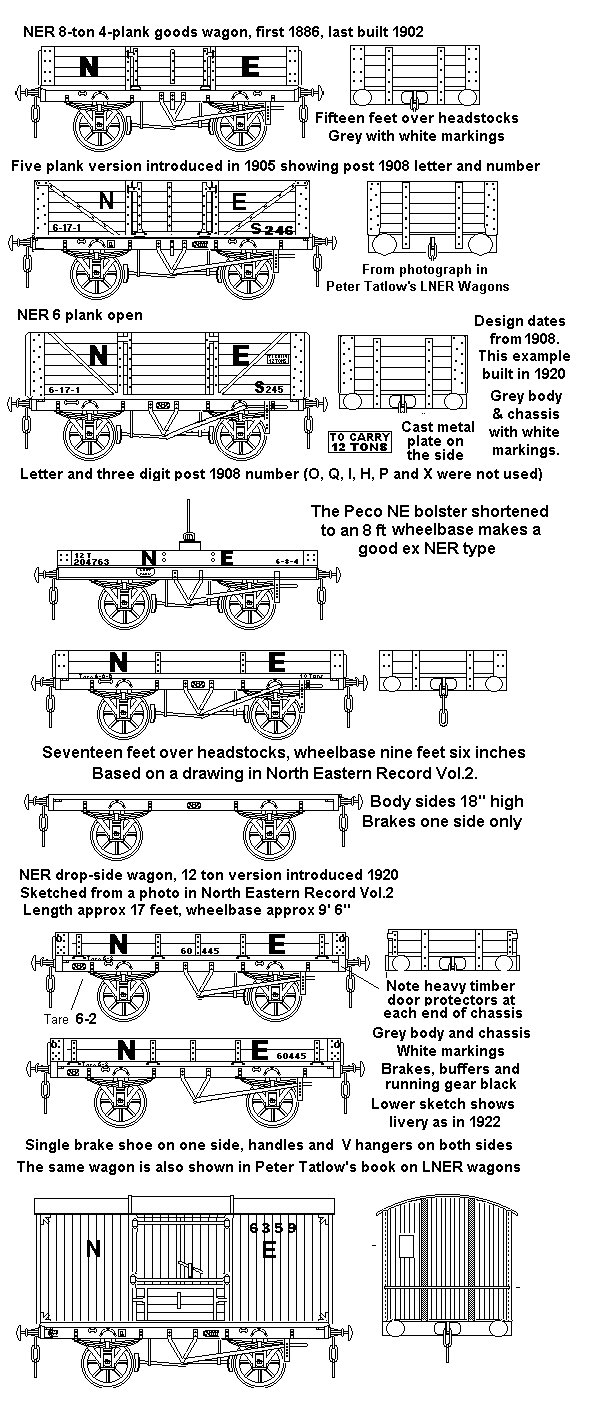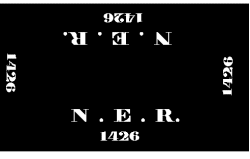
North Eastern Railway
(Note: Numbers in brackets refer to specific references)
The NER was formed in 1854 by an amalgamation of the York, Newcastle & Berwick Railway, the Leeds Northern Railway, the York and North and the Malton and Driffield Railway. It went on to absorb several other lines including the famous Stockton & Darlington (absorbed in 1863) and was the largest constituent of the LNER at the 1923 grouping.
The NER served an area running north from Doncaster to Tweedmouth and operated services to Carlisle, Penrith Tebay and Leeds. The NER was the first of the really large and monopolistic railway companies. The company owned the docks at West Hartlepool and its policies on charging for traffic to the docks within its area provoked the building of the Hull & Barnsley Railway. That line is described in article XX (xx xx RM)..
The NER was at the forefront of the development of electric traction, starting with third rail current supplies but later favouring overhead wires and direct current transmission. Electric traction was installed on the short quayside line in Newcastle in 1902 and some suburban services were electrified in 1904 but these used third rail current supply only (the lines involved now form part of the Tyneside Metro third rail electric system). In 1915 it electrified the heavy freight line between Shildon and Middlesborough using overhead supply and would have continued with the line between York and Newcastle had not the First World War intervened.
With its operations divided into three divisions (North, Central and Southern) the company had some curious variations in operational detail across its territory. As an example the signals in both the Northern and Southern divisions used slotted post type signals whilst the Central Division (based on the former Stockton and Darlington Railway) used solid posts.
The railways of the north east, and the North Eastern Railway in particular, had always favoured hopper wagons and the NER had been building eight plank high (nine feet ten inches from the rail) four wheeled wooden hopper coal wagons since the turn of the century. The NER discouraged the use of private owner wagons, offering its own high capacity leased hopper wagons at competitive rates, and by the time of the 1923 grouping there were over 17,000 of the NER wagons in use. After the grouping the LNER built 7,000 more to an essentially similar design, substituting T section angle for the heavy timber ends supports used on the NER stock.
Fig ___ NER/LNER 20 ton hopper wagons
Hopper wagons have to be discharged into under-track bunkers, if the lay of the land did not allow a track to be run out over a natural drop the NER built ramped sections of track leading to an elevated coal drop. It was not advisable to excavate a hollow and run the track over that is it tended to flood. The NER were in the forefront of hopper use and relatively few ramps and drops were built by other companies. Because the facilities were in place to handle these wagons British Railways actually built a number of the NER designed wagons to maintain services in this area.
Goods stock had grey bodies and chassis with black ironwork below the solebar and white lettering. Originally the initials used were N E R in six inch high white lettering, shaded black placed toward the upper left of the body, the wagon number being placed on the upper body on the right. In 1904 they stopped using the black shading and in 1911 they changed to using the initials N E in plain white lettering twelve inches high in the usual places on the sides. It can be difficult to tell on black and white photo's whether the livery is NER grey or LNER bauxite, the smaller initials and the placement of the number are points to watch for. The NER had the largest fleet of goods stock in the country and about the turn of the century they reached to point of needing six digit numbers on rolling stock. This was not deemed a good idea and in 1908 (1 Vol.2) they introduced a system of a single letter followed by three numbers. Several letters were not used in the letters and number scheme, O, Q, I, H, P and X were excluded, some because they might be confused with numbers. Mineral wagons were also marked ND, CD or SD indicating Northern, Central or Southern divisions. In 1917, as the common user system came into effect, the Government requested they change back to using all-numbers but it was well into the LNER period before all the lettered stock was changed to six digit numbers.
The NER brake vans were originally painted dark brown but from 1904 they, and vacuum fitted stock, were painted Indian red. Goods brake vans, in addition to being associated with one of the three divisions, were also permanently assigned to either goods or mineral duties
Service stock was painted standard goods colours except for the locomotive department wagons which were painted a light blue, slightly lighter than British Rail's intercity blue.
The NER passenger stock was painted all-over in a dark maroon, usually called 'crimson lake', very similar to the Midland Railway carriage colour but this weathered to a browner red than Midland stock. The NER bogie petrol-electric railcars introduced in 1903 were painted maroon with cream upper panels. From 1904 goods loco's were painted black.
Fig ___ NER

The model of the NER outside framed van is a cut-down Peco refrigerator van body with bracing from 20x20 thou strip.
The other short wheelbase van is similar to the van described in Article XX (XX XX RM) but shows an earlier design with external flat strapping on the sides. The sliding roof door was replaced by a tarpaulin after 1911.
The long wheelbase van dates from 1902, the model uses the sides from two refrigerator van kits left over from other conversions, these are fitted to a Peco pallet van body. The chassis is the Peco fifteen foot type with modified brake handles as shown. This should have been extended at each end as shown in the drawing to produce a correct length model, I did not have the accurate dimensions when I built mine, the figures in brackets are the dimensions if using an unaltered chassis.
The four plank open is a cut down Peco five plank body mounted on a shortened ten foot wheelbase chassis.
The two plank dropside open wagon is from a photograph in LNER wagons by Peter Tatlow's book on LNER wagons (3). I believe this wagon had a ten foot wheelbase.
The plate trestle wagon is either from the LNER wagon book (3) or from an illustration in NE Record Vol 2 - I have not yet decided which form of bracing to use.

References:
(1) The Historical Model Railway Society has published three books which should be essential reading for anyone modelling this line or the Hull and Barnsley Railway:
North Eastern Record Vol.1 (1988 ISBN 0902835130) Covers lineside matters including signalling as well a shipping and road transport.
North Eastern Record Vol.2 (1997 ISBN 090283519x) Covers passenger and goods rolling stock liveries of the NER and H&BR in considerable detail.
North Eastern Record Vol.3 (2000 ISBN 0902835203) Covers the liveries of the locomotives used by the NER and H&BR.
(2) The North Eastern Railway by G. J. Allen, published by Ian Allen in 1964 (ISBN Unknown) offers a good general history of the line.
(3) A Pictorial Record of LNER Wagons by Peter Tatlow - OPC - 1976 - ISBN 0 92888 92 7 Contains several photographs of NER wagons and a few H&BR examples.
Societies:
North Eastern
Railway Association
This site is apparently under construction (2018) but the links to individual pages all seem to work fine.
Available Models in N/2mm scales
The Graham Farish bogie van is a North Eastern vacuum braked design dating from 1906. The lettering on the Farish vehicle is actually (I believe) NER rather than LNER although the body colour should be a rather darker red than the supplied 'red oxide'. The NE 'sand' wagon in the Graham Farish range is (I believe) and NER wagon, the blue body colour is correct for departmental wagons attached to the locomotive department.
Bill Bedford Models, Leebiton, Sandwick, Shetland, ZE2 9HP
Mr. Bedford offers etched kits of a North Eastern Railway/LNER outside framed brake van and horizontal planked brake van.
Acknowledgements
Thanks are due to Mike Grocock of the NERA for his assistance in the preparation of this article. The wagon sheet illustration is by courtesy of the HMRS.